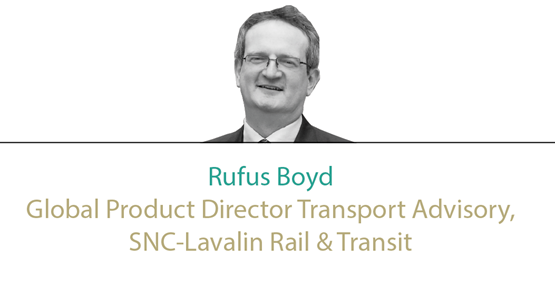Just think of how many electric cars will be parked at railway stations in the future. Consumers will want charging facilities. The parked cars could even be used as short-term energy reservoirs to feed into the railway system, mitigating the impact of rail electrical peak loading, and still be fully charged for consumers returning to their cars after their journeys. Smart energy management systems could be deployed to provide benefits to rail, consumers and the environment. The UK has the opportunity to lead the world, facilitated by well-thought through and integrated infrastructure systems investments.
Even more integrated thinking via the application of “Mobility as a Service” - providing consumers with personalised, relevant and real-time journey options through smart devices - is another technology-enabled area where the UK could take a lead. This also needs joined-up systems thinking, bringing together information technology, communications, transport operators (across the modes) and consumers to provide an improved customer experience and society with a more efficient, sustainable and cost-effective mobility system. A pre-requisite to realise this is collaboration across central and local government, regulators, industries and consumer groups.

Decisions about transport infrastructure shape the type of housing and settlement patterns that we end up with. This can vary from car-based, polluting, sprawling and isolated suburban extensions to sustainable, people-focused,
inclusive and well-planned communities. The former locks
people into unsustainable travel habits and creates long-term costs. The latter provides long-term benefits which range from better public health to cleaner air and increased productivity.
Rail projects can support sustainable development by opening up land for housing and employment activity. When done correctly, it gets people out of their cars and helps to tackle the serious problems of congestion and air pollution in many towns and cities. Improved transport connectivity attracts inward investment, and development around railway stations can act as a catalyst for wider regeneration.
Until recently, there has been insufficient discussion on how transport infrastructure can help to solve the various housing crises that are occurring across the country. Our research shows that in many English city-regions, the majority of new housing development is not being developed around new or existing rail connections. While bus networks can play an important role, we run the risk of creating new car-dependent communities which are not sustainable in the long-term.
The challenge to overcome is that the benefits from well-planned transport infrastructure investment occur over the medium to long term, and can be difficult to quantify. This can result in infrastructure projects that could act as catalysts for sustainable growth not being approved. Meanwhile, the negative impacts of ‘quick-win’ schemes are often downplayed, such as capacity increases on the road network which generate additional traffic.
The Department for Transport has made some positive steps towards improving its appraisal process, but more needs to be done. To realise these wider benefits, we need to link up transport and spatial planning at a range of scales.
This is starting to happen. New bodies such as Transport for the North can take a regional approach to increasing rail capacity and coverage, making it the natural choice for inter-city travel. Combined authorities can use strategic planning tools such as Local Development Orders and Development Corporations to co-ordinate new transport infrastructure with development, and to capture the land value uplift that results from public investments in improved connectivity.
At the local level, proactive planning departments can work with transport professionals to create great places around railway stations.
Examples from across the country show how planners can help to make the strategic case for transport investment, from the Nottingham tram extension to Salford’s MediaCity, and from London’s Barking Riverside to the Cranbrook development in Devon. By working together with the industry, professional bodies such as ourselves are showing that with good strategic planning, transport infrastructure pays.

It is axiomatic that integration of transport and housing (and its infrastructure) would lead to better socio-economic outcomes. Paul Clifton has drawn on some well-known (Battersea and ‘Metroland’) and some less well-known (Reading’s Green Park)
examples to illustrate the problem/opportunity. The challenge is how much integration, by whom, and in what order. The more planning bureaucracy applied to a process, the slower it becomes and the less appetite there is from the private sector to participate (with an impact on funding). Balance, as ever, is everything.
Public policy - and the bargaining between local planners and national Government - has pointed additional housing to capacity-enhanced railways as at Ashford (HS1), Milton Keynes (WCML upgrade) and Crawley/Horsham (Thameslink). Even once quiet towns such as Market Harborough, where I was a station manager 25 years ago, have thrived on better frequencies and speeds. What the Reading Green Park example shows is the limits of the rail system and the substantial costs of delivering even minor upgrades when relieving constraints such as signalling and rolling stock cause step-functions in cost. This is a key and recurring theme that complicates planning, rather than being a fault of the system.
Some years ago I was involved in the sale of track access over the West London Line. A sub-decision was how many new stations would be built and where, with what impact upon capacity. Planning the prioritisation between local government and the railways ensured that the focus was upon Imperial Wharf (housing) and Shepherds Bush (retail). The rail plan and the local plan came together but, as is often the case, this was in the context of the special case of London. So how do we achieve this outside of London?
Paul Harwood offers the positive case of Cranbrook, which is part of a wider effort by Devon County Council (always forward-looking on transport) to create a rail hub at Exeter and push sustainable development to current and new stations served by cross-city services. Some of these developments have taken time to get off the ground, which may be further evidence of system sclerosis of the type Paul Clifton sees everywhere, but potentially evidence of high rail costs.
Paul Harwood also addresses new station funding. He is surely right that developers will resist funding faraway network enhancements, although local government can be more enlightened - think Wales championing a Reading upgrade. A funder I know has complained that the railways just didn’t get developers, who like things simple: “Tell me how much money you want and we’ll tell you if we can afford it.”
High costs and knitting multiple funding sources slow progress. Adding more complexity and planning bureaucracy will in turn make smaller Green Park-style schemes unattractive despite the business case. Some simple innovation would help - council tax rates have not kept pace with house price inflation, making them a poor way of leveraging value from new houses.
Finally, while the Metropolitan Railway was a good example of a transport scheme leveraging in housing investment, it was not (by modern standards) a great example of planning co-ordination. The densities were light and the sprawl considerable, and within 60 years we would have probably chosen a different path more aligned to current Transit Orientated Development.
So doing the right thing matters as much as how it’s done, and it is this (above all) that may be causing people to move cautiously.











